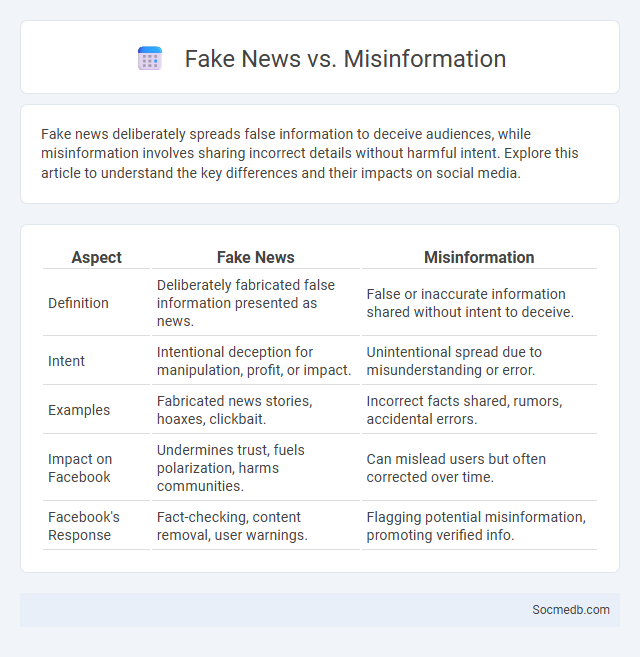
Photo illustration: Fake News vs Misinformation
Fake news deliberately spreads false information to deceive audiences, while misinformation involves sharing incorrect details without harmful intent. Explore this article to understand the key differences and their impacts on social media.
Table of Comparison
| Aspect | Fake News | Misinformation |
|---|---|---|
| Definition | Deliberately fabricated false information presented as news. | False or inaccurate information shared without intent to deceive. |
| Intent | Intentional deception for manipulation, profit, or impact. | Unintentional spread due to misunderstanding or error. |
| Examples | Fabricated news stories, hoaxes, clickbait. | Incorrect facts shared, rumors, accidental errors. |
| Impact on Facebook | Undermines trust, fuels polarization, harms communities. | Can mislead users but often corrected over time. |
| Facebook's Response | Fact-checking, content removal, user warnings. | Flagging potential misinformation, promoting verified info. |
Understanding the Terminology: Fake News vs Misinformation
Fake news refers to deliberately fabricated information designed to deceive and manipulate public opinion, often spread through social media platforms to create confusion or influence political outcomes. Misinformation involves the unintentional sharing of false or inaccurate information without harmful intent, frequently resulting from misunderstandings or incomplete knowledge. Distinguishing fake news from misinformation requires analyzing the intent behind the content and verifying the credibility of sources on social media channels.
Historical Evolution of Fake News
The historical evolution of fake news traces back to ancient times when propaganda and misinformation were used as tools for political manipulation and social control. With the invention of the printing press in the 15th century, the spread of fabricated stories accelerated, influencing public opinion during events like the Reformation and the yellow journalism era of the late 19th century. The rise of social media platforms in the 21st century exponentially increased the speed and reach of fake news, enabling rapid dissemination and complicating efforts to verify authenticity and combat misinformation.
What Constitutes Misinformation?
Misinformation on social media refers to false or misleading information spread without intent to deceive, often stemming from rumors, outdated data, or misinterpretations. It typically includes inaccurate news, manipulated images, and unverified claims that can rapidly circulate across platforms like Facebook, Twitter, and Instagram. Understanding the distinction between misinformation and disinformation is crucial, as misinformation lacks deliberate intent to harm but still contributes to public confusion and misinformation cascades.
Key Differences Between Fake News and Misinformation
Fake news refers to deliberately fabricated information designed to deceive and spread falsehoods, often created to influence public opinion or generate profit through sensationalism. Misinformation involves the unintentional sharing of incorrect or misleading information without the intent to deceive, typically stemming from misunderstandings or lack of verification. Understanding these distinctions is crucial for social media platforms, which implement fact-checking algorithms and user education to combat false narratives effectively.
Real-World Examples: Fake News in Action
Social media platforms like Facebook and Twitter have become hotspots for the rapid spread of fake news, impacting public opinion and political outcomes. One notable example is the 2016 U.S. presidential election, where fabricated stories and misleading content influenced voter perceptions and amplified misinformation. Studies indicate that false news spreads faster and reaches more people than verified information, highlighting the urgent need for improved digital literacy and robust fact-checking mechanisms.
How Misinformation Spreads Online
Misinformation spreads rapidly on social media platforms due to algorithmic promotion of engaging but often misleading content, user-generated sharing, and echo chambers that reinforce false beliefs. False information leverages emotional triggers and sensational headlines, increasing virality and reducing critical evaluation by users. Fact-checking mechanisms struggle to keep pace with the volume and speed of misinformation dissemination across networks like Facebook, Twitter, and Instagram.
Psychological Impact of Consuming False Information
Consuming false information on social media significantly affects mental health by increasing anxiety, stress, and confusion. Exposure to misinformation can distort perception of reality, leading to mistrust in reliable sources and emotional distress. Prolonged engagement with deceptive content also contributes to cognitive overload and impaired decision-making processes.
The Role of Social Media in Amplifying Fake News
Social media platforms like Facebook, Twitter, and Instagram have become significant channels for the rapid spread of fake news, often bypassing traditional editorial controls. Algorithms prioritize sensational and emotionally charged content, increasing the visibility of misinformation and contributing to widespread disinformation during critical events such as elections and public health crises. The viral nature of posts combined with user-generated sharing exacerbates the challenge of identifying and curbing fake news in online environments.
Strategies for Identifying and Combating Fake News
Effective strategies for identifying fake news on social media include verifying information through reputable sources and cross-referencing multiple credible outlets. Employing fact-checking tools like Snopes, FactCheck.org, and integrating AI-powered detection algorithms enhances the accuracy of identifying misinformation. Promoting digital literacy and encouraging critical thinking among users further strengthens the defense against the spread of false content.
Building Media Literacy: Protecting Against Information Disorder
Building media literacy enhances your ability to critically evaluate social media content, helping to identify misinformation, disinformation, and malinformation. By developing skills in source verification, fact-checking, and recognizing biased or manipulated information, you reduce the risk of falling victim to information disorder. Empowered media literacy strengthens your digital resilience and promotes informed decision-making in the online environment.
 socmedb.com
socmedb.com